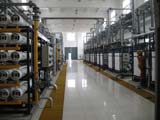Energy & Environmental Research Center has developed a system that produces high-pressure hydrogen on demand.
InEnTec Chemical's new facilities will convert hazardous and non-hazardous chemical residuals into useful products and fuels.

Reverse osmosis treatment requires sufficient feedwater pretreatment to prevent membrane fouling. Depending on the feedwater, pretreatment can be critical to ensuring a sustainable process.
The World Wildlife Fund and others expect to develop a set of tools to help the world's poorest people obtain the benefits of carbon sequestration through the Carbon Benefits Project.
The Missouri Joint Municipal Electric Utility Commission lowered its energy use and greenhouse gas emissions using a combustion turbine-based combined heat and power system.
University of Massachusetts scientists have created an accurate test for arsenic compounds in soil.
A new GE technology lowers fuel usage at crude furnaces.
The West Coast Regional Carbon Sequestration Partnership got the go-ahead to inject 2,000 tons of carbon dioxide into a saline formation in Joseph City, Ariz.
Central Motor Wheel of America, Inc., during a energy-saving initiative, contacted Durr Systems to help determine how to reduce fuel consumption at its plant.
Chinook Sciences and European Metal Recycling will convert auto shredder residue into renewable energy and recover metals in the process.
DOE's Argonne National Laboratory has developed an RFID technology to monitor containers of nuclear materials.
Scientists from Virginia, Sweden and the Savannah River National Laboratory say carbon nanostructures can be used as catalysts to store and release hydrogen.
EPA's new chemical toxicity strategy will incorporate methods that use advances in molecular biology, genomics, and computational sciences.

Whether it is on coral reef bleaching, industrial thermal loading, or modeling freshwater fish populations, researchers and resoure managers must have temperature data collection methods that are accurate, reliable, and practical.